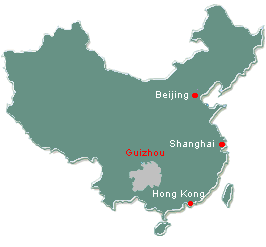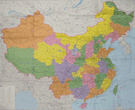|
|
|
Geography of Guizhou |
Guizhou Province, "Qian" or "Gui" for short, is situated in the
south-western part of China. The Province covers an area of over
176,167 square kilometres and has population of more than 38.56 million
(2022),
there are total of 49 nationalities live in Guizhou,
including
Han,
Yao,
Miao,
Dong,
Bouyei,
Tujia,
Li,
Gelao,
Sui,
Hui,
Bai,
Zhuang,
etc.
Guiyang is the capital of the Province.
Guizhou occupies the eastern part of the Yungui Plateau, rising between
the Sichuan Basin and
Guangxi Basin. The Terrain of Guizhou
gradually lowers down eastwards, its western and central part having an
attitude of one to two thousand meters above sea level. The river valley
area on the south-eastern fringe of the province has an altitude of
around 500 meter above sea level. Guizhou has a rugged terrain, with
numerous precipitous peaks and deep valleys, as well as extensive karsts
formations, caves and underground rivers. Many date-shaped mini-basins
scatter around the mountains.
The
Dalou Mountains in the northern part of the province forms the
borderline of Guizhou. The Wuling Mountains in the north-eastern part of
the province abounds in biological resources and has been declared as a
key natural preserves of China. The Wumeng Mountains in the west borders
Yunnan Province. The Miaoling Mountains in the central part of the
province is the watershed between the Changjiang River (Yangtze River)
system and Pearl River system. The major rivers flowing through the
province are the Wujiang River, the Chishuihe River, the Qingshui River,
the Nanpan River (the boundary river between Guizhou and
Guangxi), the
Beipan River. These rivers have the common features of being wide and
open upstream but narrow downstream. They have rich hydraulic resources
with their rapid flows of water, shoals and falls.
|
|
|
Climate of Guizhou |
Guizhou has a humid monsoon climate of the subtropical zone, with
neither severe winter nor hot summer. The average annual temperature of
province is between 14ºC-16ºC
(57 ºF -61 ºF).
The average temperature of January, the coldest month, is between 4ºC-9ºC
(39 ºF - 48ºF)
and that of July, the
warmest month, is between 22ºC-26ºC
(72 ºF
and 79 ºF). The
annual average precipitation of Guizhou is between 900-1500mm. Most of
the area in the province have long frost-free period, where two or three
cropping system is practiced.
|
|
|
Brief History of Guizhou |
|
Back in the Shang Dynasty, Guizhou was part of Gui-Fang (16th century
-11th century B.C). Druing the Xizhou Dynasty the Xizhou Dynasty (11th
century-771 B.C), Guizhou was under the administration of Kingdoms of
Jing and Chu. In the period of Spring and Autumn and Warring States
(771-221 B.C), a number of tribal settlements emerged in Guizhou, the
large ones among them being Yelang, Qielan , and so on.
Druing the Qin
Dynasty (221-207 B.C), Qianzhong, Xiang, Ba and Shu prefectures were
established in Guizhou. In the Han Dynasty (206 B.C—220 A.D), Guizhou
was under the separate and administration of Zangke Prefecture and
Wuling Prefecture. Guizhou became Qianzhong Prefecture during the Tang
Dynasty (618-907). Buzheng Prefecture Administration was established in
Guizhou in Ming Dynasty (1368-1644). Guizhou Province was set up in the
region in the Qing Dynasty (1644-1911) which has remained unchanged till
today.
|
|
|
Resources of
Guizhou Guizhou Province |
|
Guizhou abounds in mineral resources, such as mercury, phosphate,
aluminium, coal, iron, antimony, lead, zinc and other rare metals.
Guizhou has the largest mercury deposits in the nation hence are known
as the home of mercury. Its main grain crops are rice and corn. Such
cash crops as flue cured tobacco; rapeseed, tea and hemp are also
growing in Guizhou. Guizhou abounds in timber resources and is China's
leading grower of China fir. China fir grow in Jinping is renowned
throughout the country.
|
|
|
Guizhou Local Cuisine |
|
Braised salamander and Eight Delicacies and Feast of Tianmahan Chicken
are famous local dishes with high nutrition. Love Bean Curd Fruit and
Bijie Stuffed Dumplings are popular refreshments with diners. |
|
|
Places of Interest and Tourist Attractions: Guizhou |
|
|
|
|
|
|
|
|
|
Guizhou Useful Links and Sites |
|
|
|
|
Guizhou
Related Article and Report Links |
|
|
|
|
|
|
|
|



